Critical Evaluation of Innovation at Revolut Ltd: A Report
VerifiedAdded on 2021/02/19
|13
|3488
|378
Report
AI Summary
This report provides a comprehensive analysis of innovation theory, specifically focusing on its application within Revolut Ltd, a financial technology company. The introduction offers a brief overview of Revolut Ltd, highlighting its services and market position. The main body delves into the Diffusion of Innovation theory, explaining its core concepts, including adopter categories (Innovators, Early Adopters, Early Majority, Late Majority, and Laggards) and the factors affecting the adoption of innovation (Relative Advantage, Compatibility, Complexity, Triability, and Observability). The report then critically evaluates the advantages and disadvantages of the theory. Furthermore, the report examines the implications of innovation theory within Revolut Ltd, discussing how the company leverages innovation to develop products and services, attract customers, and maintain a competitive edge in the financial market. The report concludes by summarizing the key findings and insights regarding Revolut's innovation strategies and their impact on the company's success.
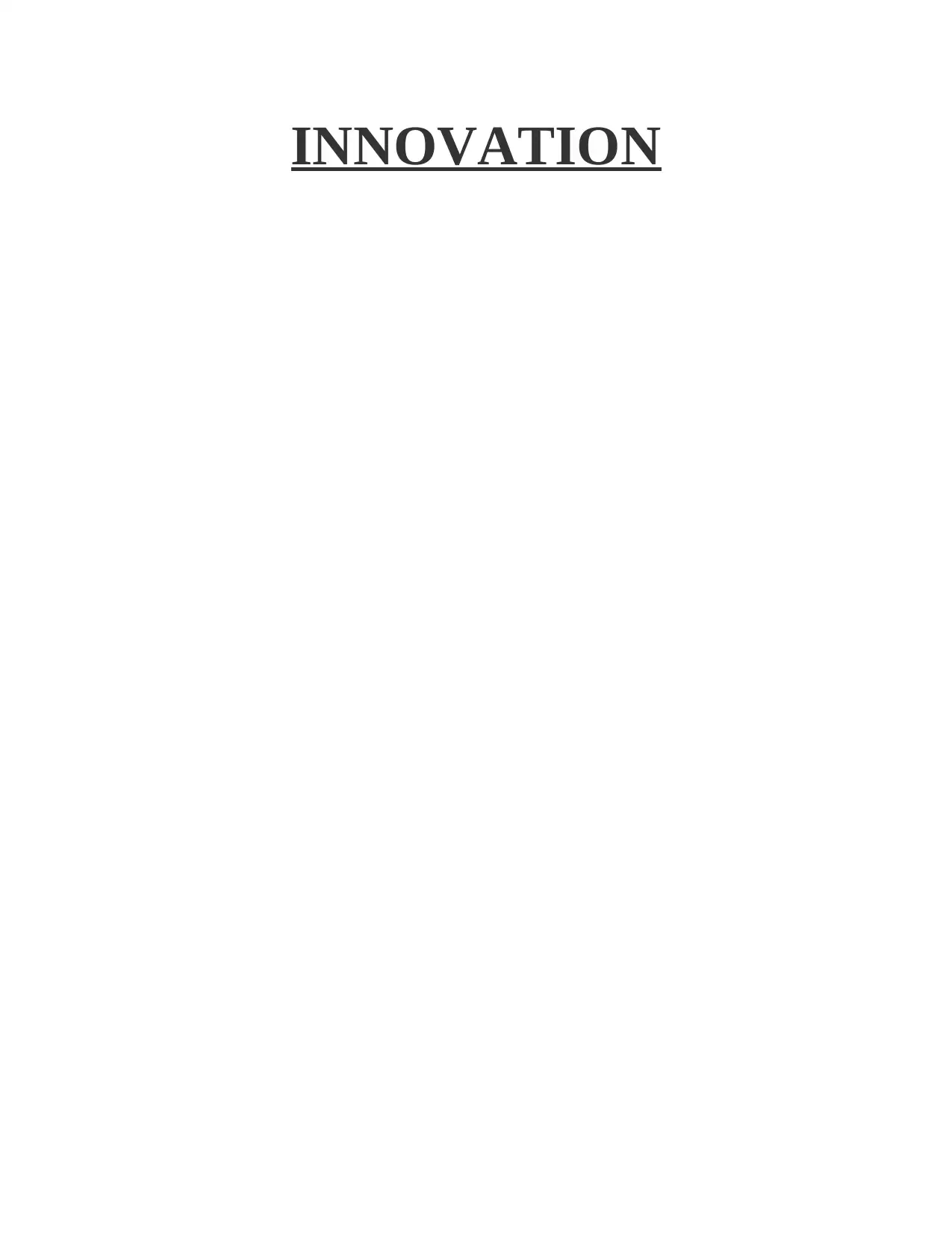
INNOVATION
Paraphrase This Document
Need a fresh take? Get an instant paraphrase of this document with our AI Paraphraser
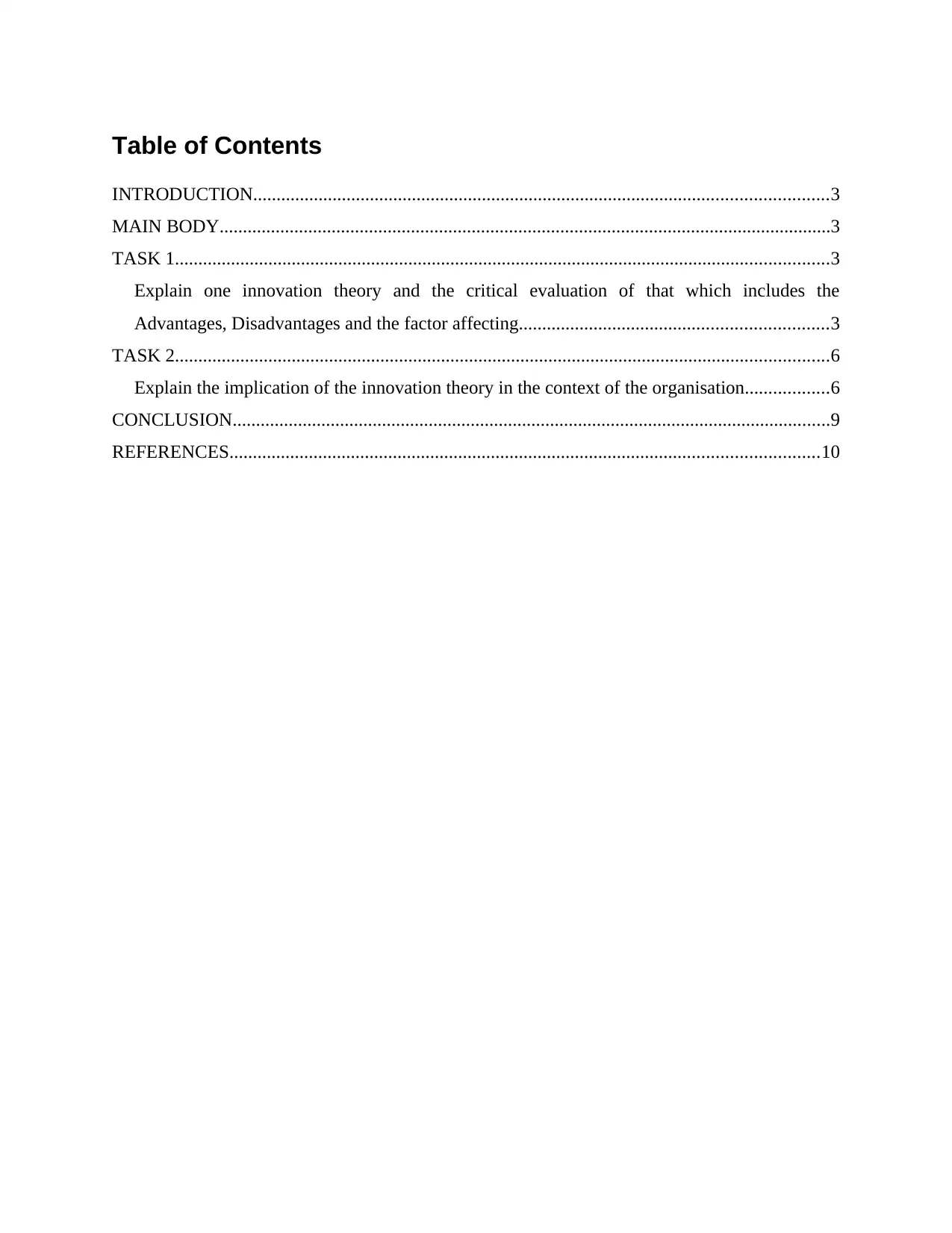
Table of Contents
INTRODUCTION...........................................................................................................................3
MAIN BODY...................................................................................................................................3
TASK 1............................................................................................................................................3
Explain one innovation theory and the critical evaluation of that which includes the
Advantages, Disadvantages and the factor affecting..................................................................3
TASK 2............................................................................................................................................6
Explain the implication of the innovation theory in the context of the organisation..................6
CONCLUSION................................................................................................................................9
REFERENCES..............................................................................................................................10
INTRODUCTION...........................................................................................................................3
MAIN BODY...................................................................................................................................3
TASK 1............................................................................................................................................3
Explain one innovation theory and the critical evaluation of that which includes the
Advantages, Disadvantages and the factor affecting..................................................................3
TASK 2............................................................................................................................................6
Explain the implication of the innovation theory in the context of the organisation..................6
CONCLUSION................................................................................................................................9
REFERENCES..............................................................................................................................10
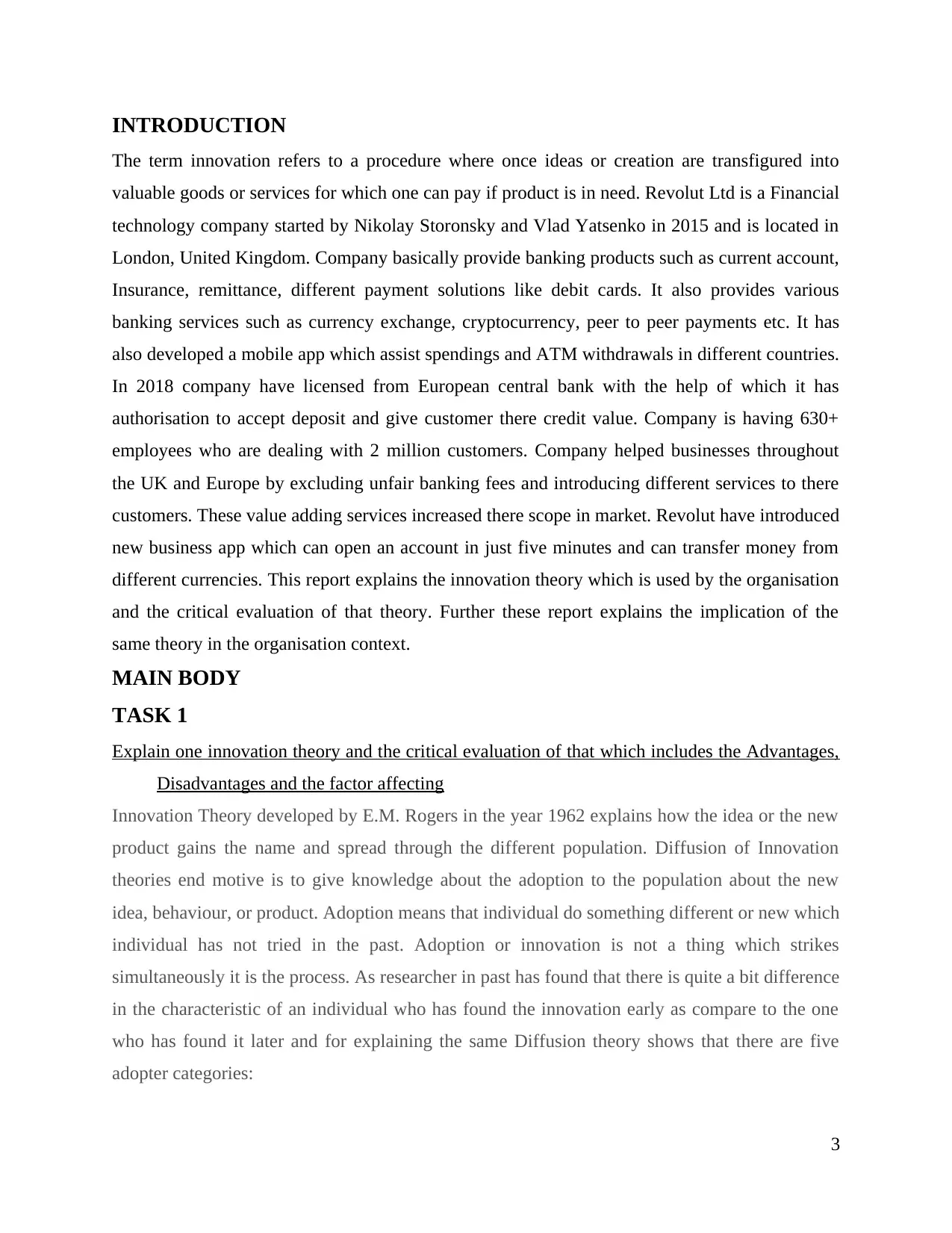
INTRODUCTION
The term innovation refers to a procedure where once ideas or creation are transfigured into
valuable goods or services for which one can pay if product is in need. Revolut Ltd is a Financial
technology company started by Nikolay Storonsky and Vlad Yatsenko in 2015 and is located in
London, United Kingdom. Company basically provide banking products such as current account,
Insurance, remittance, different payment solutions like debit cards. It also provides various
banking services such as currency exchange, cryptocurrency, peer to peer payments etc. It has
also developed a mobile app which assist spendings and ATM withdrawals in different countries.
In 2018 company have licensed from European central bank with the help of which it has
authorisation to accept deposit and give customer there credit value. Company is having 630+
employees who are dealing with 2 million customers. Company helped businesses throughout
the UK and Europe by excluding unfair banking fees and introducing different services to there
customers. These value adding services increased there scope in market. Revolut have introduced
new business app which can open an account in just five minutes and can transfer money from
different currencies. This report explains the innovation theory which is used by the organisation
and the critical evaluation of that theory. Further these report explains the implication of the
same theory in the organisation context.
MAIN BODY
TASK 1
Explain one innovation theory and the critical evaluation of that which includes the Advantages,
Disadvantages and the factor affecting
Innovation Theory developed by E.M. Rogers in the year 1962 explains how the idea or the new
product gains the name and spread through the different population. Diffusion of Innovation
theories end motive is to give knowledge about the adoption to the population about the new
idea, behaviour, or product. Adoption means that individual do something different or new which
individual has not tried in the past. Adoption or innovation is not a thing which strikes
simultaneously it is the process. As researcher in past has found that there is quite a bit difference
in the characteristic of an individual who has found the innovation early as compare to the one
who has found it later and for explaining the same Diffusion theory shows that there are five
adopter categories:
3
The term innovation refers to a procedure where once ideas or creation are transfigured into
valuable goods or services for which one can pay if product is in need. Revolut Ltd is a Financial
technology company started by Nikolay Storonsky and Vlad Yatsenko in 2015 and is located in
London, United Kingdom. Company basically provide banking products such as current account,
Insurance, remittance, different payment solutions like debit cards. It also provides various
banking services such as currency exchange, cryptocurrency, peer to peer payments etc. It has
also developed a mobile app which assist spendings and ATM withdrawals in different countries.
In 2018 company have licensed from European central bank with the help of which it has
authorisation to accept deposit and give customer there credit value. Company is having 630+
employees who are dealing with 2 million customers. Company helped businesses throughout
the UK and Europe by excluding unfair banking fees and introducing different services to there
customers. These value adding services increased there scope in market. Revolut have introduced
new business app which can open an account in just five minutes and can transfer money from
different currencies. This report explains the innovation theory which is used by the organisation
and the critical evaluation of that theory. Further these report explains the implication of the
same theory in the organisation context.
MAIN BODY
TASK 1
Explain one innovation theory and the critical evaluation of that which includes the Advantages,
Disadvantages and the factor affecting
Innovation Theory developed by E.M. Rogers in the year 1962 explains how the idea or the new
product gains the name and spread through the different population. Diffusion of Innovation
theories end motive is to give knowledge about the adoption to the population about the new
idea, behaviour, or product. Adoption means that individual do something different or new which
individual has not tried in the past. Adoption or innovation is not a thing which strikes
simultaneously it is the process. As researcher in past has found that there is quite a bit difference
in the characteristic of an individual who has found the innovation early as compare to the one
who has found it later and for explaining the same Diffusion theory shows that there are five
adopter categories:
3
⊘ This is a preview!⊘
Do you want full access?
Subscribe today to unlock all pages.

Trusted by 1+ million students worldwide
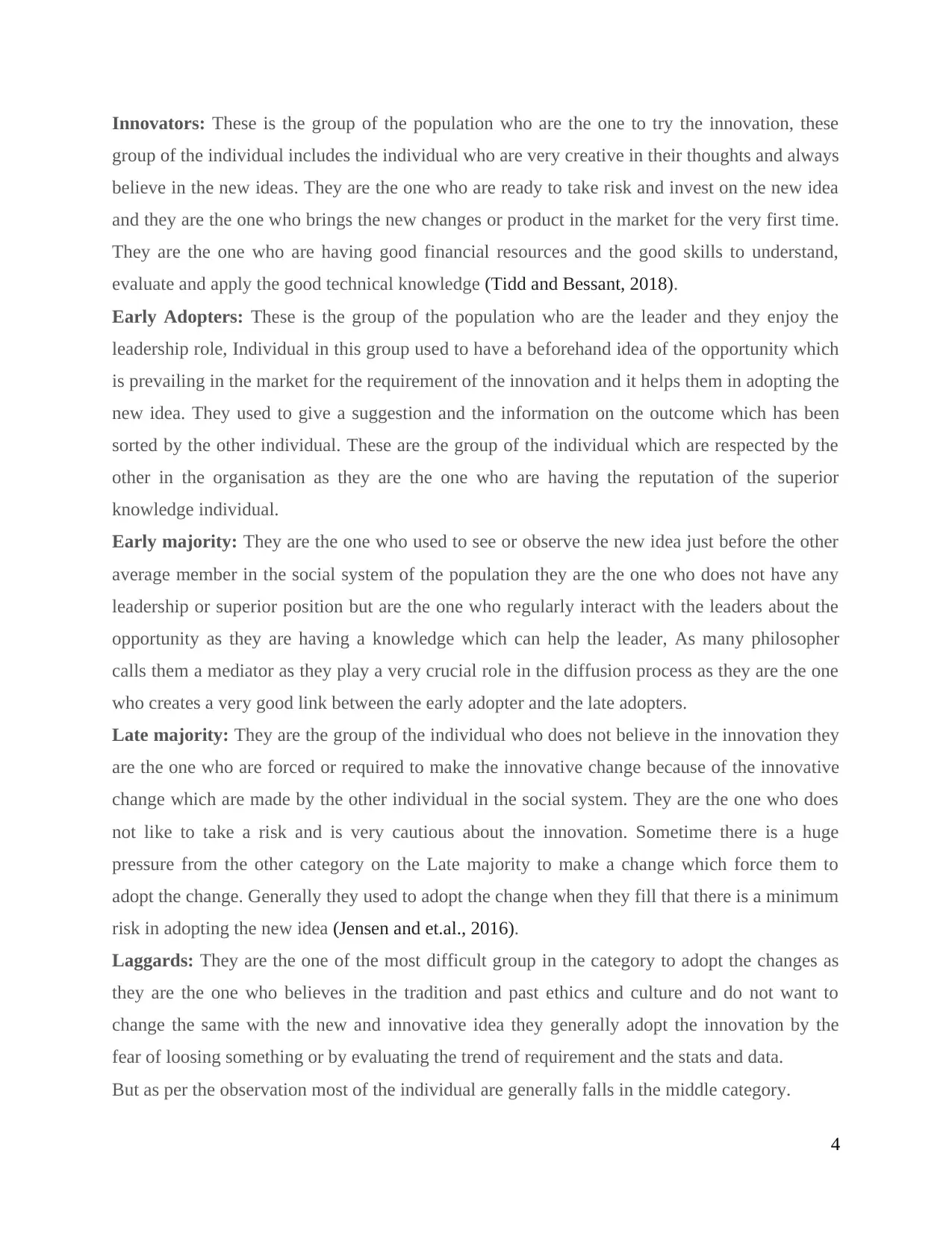
Innovators: These is the group of the population who are the one to try the innovation, these
group of the individual includes the individual who are very creative in their thoughts and always
believe in the new ideas. They are the one who are ready to take risk and invest on the new idea
and they are the one who brings the new changes or product in the market for the very first time.
They are the one who are having good financial resources and the good skills to understand,
evaluate and apply the good technical knowledge (Tidd and Bessant, 2018).
Early Adopters: These is the group of the population who are the leader and they enjoy the
leadership role, Individual in this group used to have a beforehand idea of the opportunity which
is prevailing in the market for the requirement of the innovation and it helps them in adopting the
new idea. They used to give a suggestion and the information on the outcome which has been
sorted by the other individual. These are the group of the individual which are respected by the
other in the organisation as they are the one who are having the reputation of the superior
knowledge individual.
Early majority: They are the one who used to see or observe the new idea just before the other
average member in the social system of the population they are the one who does not have any
leadership or superior position but are the one who regularly interact with the leaders about the
opportunity as they are having a knowledge which can help the leader, As many philosopher
calls them a mediator as they play a very crucial role in the diffusion process as they are the one
who creates a very good link between the early adopter and the late adopters.
Late majority: They are the group of the individual who does not believe in the innovation they
are the one who are forced or required to make the innovative change because of the innovative
change which are made by the other individual in the social system. They are the one who does
not like to take a risk and is very cautious about the innovation. Sometime there is a huge
pressure from the other category on the Late majority to make a change which force them to
adopt the change. Generally they used to adopt the change when they fill that there is a minimum
risk in adopting the new idea (Jensen and et.al., 2016).
Laggards: They are the one of the most difficult group in the category to adopt the changes as
they are the one who believes in the tradition and past ethics and culture and do not want to
change the same with the new and innovative idea they generally adopt the innovation by the
fear of loosing something or by evaluating the trend of requirement and the stats and data.
But as per the observation most of the individual are generally falls in the middle category.
4
group of the individual includes the individual who are very creative in their thoughts and always
believe in the new ideas. They are the one who are ready to take risk and invest on the new idea
and they are the one who brings the new changes or product in the market for the very first time.
They are the one who are having good financial resources and the good skills to understand,
evaluate and apply the good technical knowledge (Tidd and Bessant, 2018).
Early Adopters: These is the group of the population who are the leader and they enjoy the
leadership role, Individual in this group used to have a beforehand idea of the opportunity which
is prevailing in the market for the requirement of the innovation and it helps them in adopting the
new idea. They used to give a suggestion and the information on the outcome which has been
sorted by the other individual. These are the group of the individual which are respected by the
other in the organisation as they are the one who are having the reputation of the superior
knowledge individual.
Early majority: They are the one who used to see or observe the new idea just before the other
average member in the social system of the population they are the one who does not have any
leadership or superior position but are the one who regularly interact with the leaders about the
opportunity as they are having a knowledge which can help the leader, As many philosopher
calls them a mediator as they play a very crucial role in the diffusion process as they are the one
who creates a very good link between the early adopter and the late adopters.
Late majority: They are the group of the individual who does not believe in the innovation they
are the one who are forced or required to make the innovative change because of the innovative
change which are made by the other individual in the social system. They are the one who does
not like to take a risk and is very cautious about the innovation. Sometime there is a huge
pressure from the other category on the Late majority to make a change which force them to
adopt the change. Generally they used to adopt the change when they fill that there is a minimum
risk in adopting the new idea (Jensen and et.al., 2016).
Laggards: They are the one of the most difficult group in the category to adopt the changes as
they are the one who believes in the tradition and past ethics and culture and do not want to
change the same with the new and innovative idea they generally adopt the innovation by the
fear of loosing something or by evaluating the trend of requirement and the stats and data.
But as per the observation most of the individual are generally falls in the middle category.
4
Paraphrase This Document
Need a fresh take? Get an instant paraphrase of this document with our AI Paraphraser
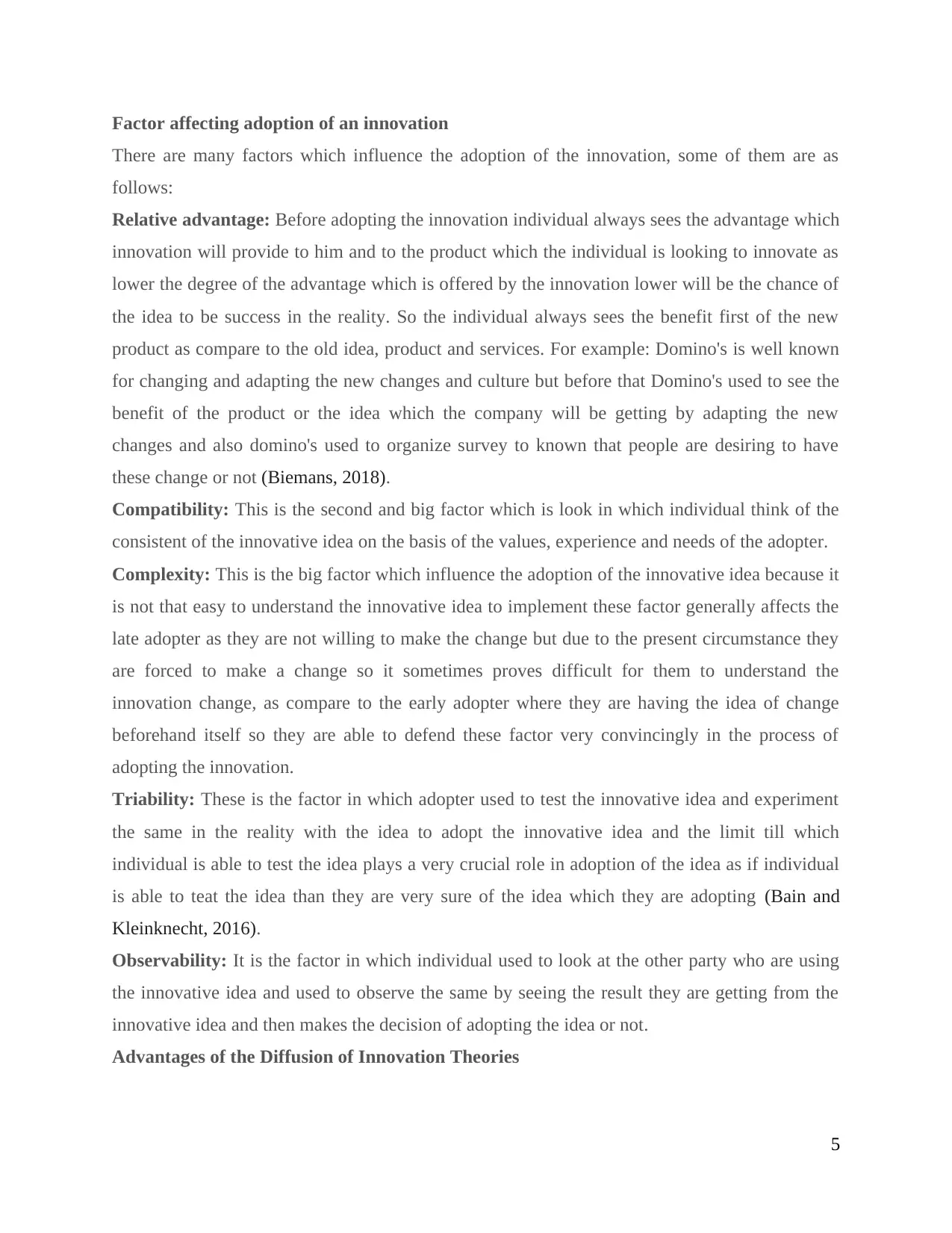
Factor affecting adoption of an innovation
There are many factors which influence the adoption of the innovation, some of them are as
follows:
Relative advantage: Before adopting the innovation individual always sees the advantage which
innovation will provide to him and to the product which the individual is looking to innovate as
lower the degree of the advantage which is offered by the innovation lower will be the chance of
the idea to be success in the reality. So the individual always sees the benefit first of the new
product as compare to the old idea, product and services. For example: Domino's is well known
for changing and adapting the new changes and culture but before that Domino's used to see the
benefit of the product or the idea which the company will be getting by adapting the new
changes and also domino's used to organize survey to known that people are desiring to have
these change or not (Biemans, 2018).
Compatibility: This is the second and big factor which is look in which individual think of the
consistent of the innovative idea on the basis of the values, experience and needs of the adopter.
Complexity: This is the big factor which influence the adoption of the innovative idea because it
is not that easy to understand the innovative idea to implement these factor generally affects the
late adopter as they are not willing to make the change but due to the present circumstance they
are forced to make a change so it sometimes proves difficult for them to understand the
innovation change, as compare to the early adopter where they are having the idea of change
beforehand itself so they are able to defend these factor very convincingly in the process of
adopting the innovation.
Triability: These is the factor in which adopter used to test the innovative idea and experiment
the same in the reality with the idea to adopt the innovative idea and the limit till which
individual is able to test the idea plays a very crucial role in adoption of the idea as if individual
is able to teat the idea than they are very sure of the idea which they are adopting (Bain and
Kleinknecht, 2016).
Observability: It is the factor in which individual used to look at the other party who are using
the innovative idea and used to observe the same by seeing the result they are getting from the
innovative idea and then makes the decision of adopting the idea or not.
Advantages of the Diffusion of Innovation Theories
5
There are many factors which influence the adoption of the innovation, some of them are as
follows:
Relative advantage: Before adopting the innovation individual always sees the advantage which
innovation will provide to him and to the product which the individual is looking to innovate as
lower the degree of the advantage which is offered by the innovation lower will be the chance of
the idea to be success in the reality. So the individual always sees the benefit first of the new
product as compare to the old idea, product and services. For example: Domino's is well known
for changing and adapting the new changes and culture but before that Domino's used to see the
benefit of the product or the idea which the company will be getting by adapting the new
changes and also domino's used to organize survey to known that people are desiring to have
these change or not (Biemans, 2018).
Compatibility: This is the second and big factor which is look in which individual think of the
consistent of the innovative idea on the basis of the values, experience and needs of the adopter.
Complexity: This is the big factor which influence the adoption of the innovative idea because it
is not that easy to understand the innovative idea to implement these factor generally affects the
late adopter as they are not willing to make the change but due to the present circumstance they
are forced to make a change so it sometimes proves difficult for them to understand the
innovation change, as compare to the early adopter where they are having the idea of change
beforehand itself so they are able to defend these factor very convincingly in the process of
adopting the innovation.
Triability: These is the factor in which adopter used to test the innovative idea and experiment
the same in the reality with the idea to adopt the innovative idea and the limit till which
individual is able to test the idea plays a very crucial role in adoption of the idea as if individual
is able to teat the idea than they are very sure of the idea which they are adopting (Bain and
Kleinknecht, 2016).
Observability: It is the factor in which individual used to look at the other party who are using
the innovative idea and used to observe the same by seeing the result they are getting from the
innovative idea and then makes the decision of adopting the idea or not.
Advantages of the Diffusion of Innovation Theories
5
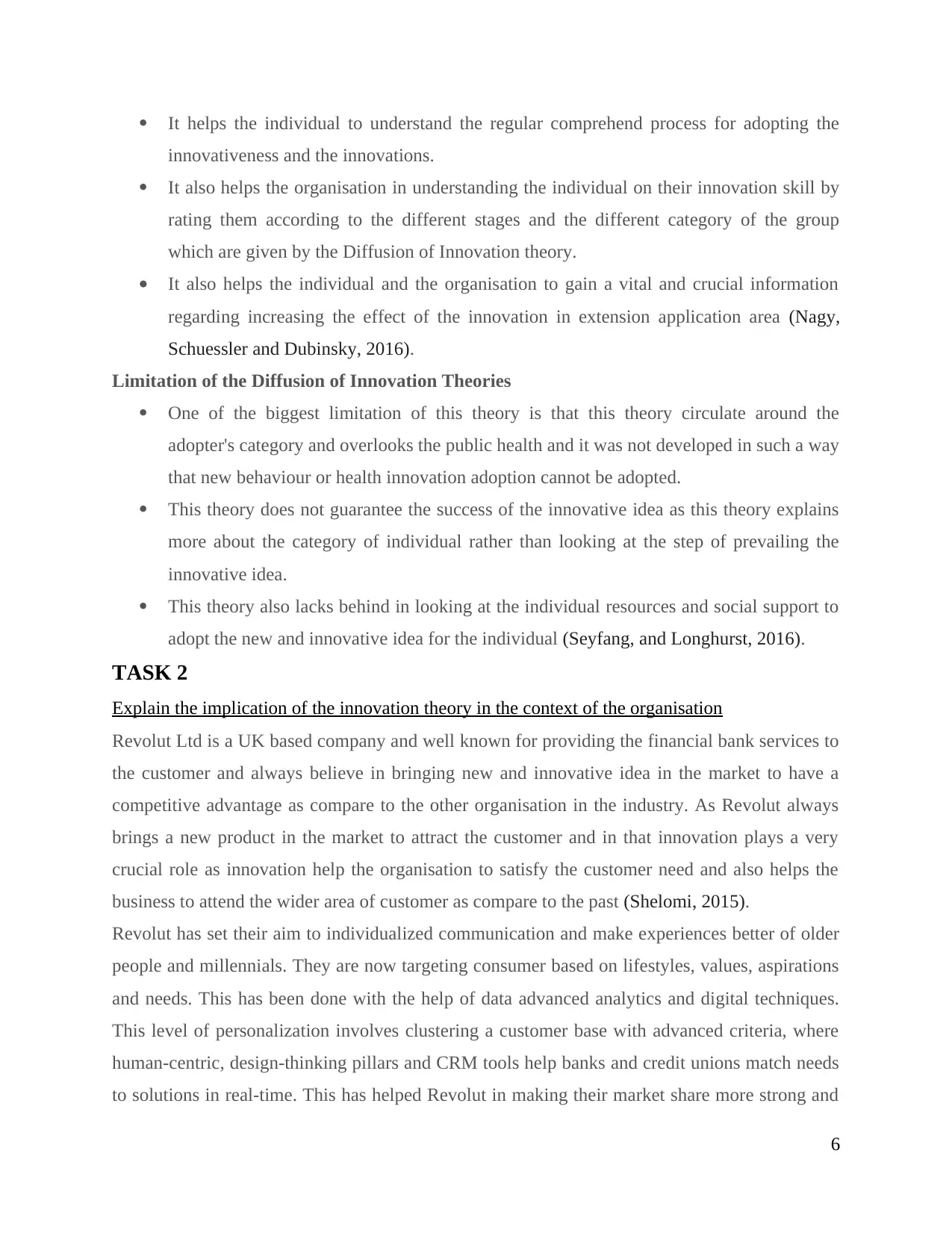
It helps the individual to understand the regular comprehend process for adopting the
innovativeness and the innovations.
It also helps the organisation in understanding the individual on their innovation skill by
rating them according to the different stages and the different category of the group
which are given by the Diffusion of Innovation theory.
It also helps the individual and the organisation to gain a vital and crucial information
regarding increasing the effect of the innovation in extension application area (Nagy,
Schuessler and Dubinsky, 2016).
Limitation of the Diffusion of Innovation Theories
One of the biggest limitation of this theory is that this theory circulate around the
adopter's category and overlooks the public health and it was not developed in such a way
that new behaviour or health innovation adoption cannot be adopted.
This theory does not guarantee the success of the innovative idea as this theory explains
more about the category of individual rather than looking at the step of prevailing the
innovative idea.
This theory also lacks behind in looking at the individual resources and social support to
adopt the new and innovative idea for the individual (Seyfang, and Longhurst, 2016).
TASK 2
Explain the implication of the innovation theory in the context of the organisation
Revolut Ltd is a UK based company and well known for providing the financial bank services to
the customer and always believe in bringing new and innovative idea in the market to have a
competitive advantage as compare to the other organisation in the industry. As Revolut always
brings a new product in the market to attract the customer and in that innovation plays a very
crucial role as innovation help the organisation to satisfy the customer need and also helps the
business to attend the wider area of customer as compare to the past (Shelomi, 2015).
Revolut has set their aim to individualized communication and make experiences better of older
people and millennials. They are now targeting consumer based on lifestyles, values, aspirations
and needs. This has been done with the help of data advanced analytics and digital techniques.
This level of personalization involves clustering a customer base with advanced criteria, where
human-centric, design-thinking pillars and CRM tools help banks and credit unions match needs
to solutions in real-time. This has helped Revolut in making their market share more strong and
6
innovativeness and the innovations.
It also helps the organisation in understanding the individual on their innovation skill by
rating them according to the different stages and the different category of the group
which are given by the Diffusion of Innovation theory.
It also helps the individual and the organisation to gain a vital and crucial information
regarding increasing the effect of the innovation in extension application area (Nagy,
Schuessler and Dubinsky, 2016).
Limitation of the Diffusion of Innovation Theories
One of the biggest limitation of this theory is that this theory circulate around the
adopter's category and overlooks the public health and it was not developed in such a way
that new behaviour or health innovation adoption cannot be adopted.
This theory does not guarantee the success of the innovative idea as this theory explains
more about the category of individual rather than looking at the step of prevailing the
innovative idea.
This theory also lacks behind in looking at the individual resources and social support to
adopt the new and innovative idea for the individual (Seyfang, and Longhurst, 2016).
TASK 2
Explain the implication of the innovation theory in the context of the organisation
Revolut Ltd is a UK based company and well known for providing the financial bank services to
the customer and always believe in bringing new and innovative idea in the market to have a
competitive advantage as compare to the other organisation in the industry. As Revolut always
brings a new product in the market to attract the customer and in that innovation plays a very
crucial role as innovation help the organisation to satisfy the customer need and also helps the
business to attend the wider area of customer as compare to the past (Shelomi, 2015).
Revolut has set their aim to individualized communication and make experiences better of older
people and millennials. They are now targeting consumer based on lifestyles, values, aspirations
and needs. This has been done with the help of data advanced analytics and digital techniques.
This level of personalization involves clustering a customer base with advanced criteria, where
human-centric, design-thinking pillars and CRM tools help banks and credit unions match needs
to solutions in real-time. This has helped Revolut in making their market share more strong and
6
⊘ This is a preview!⊘
Do you want full access?
Subscribe today to unlock all pages.

Trusted by 1+ million students worldwide
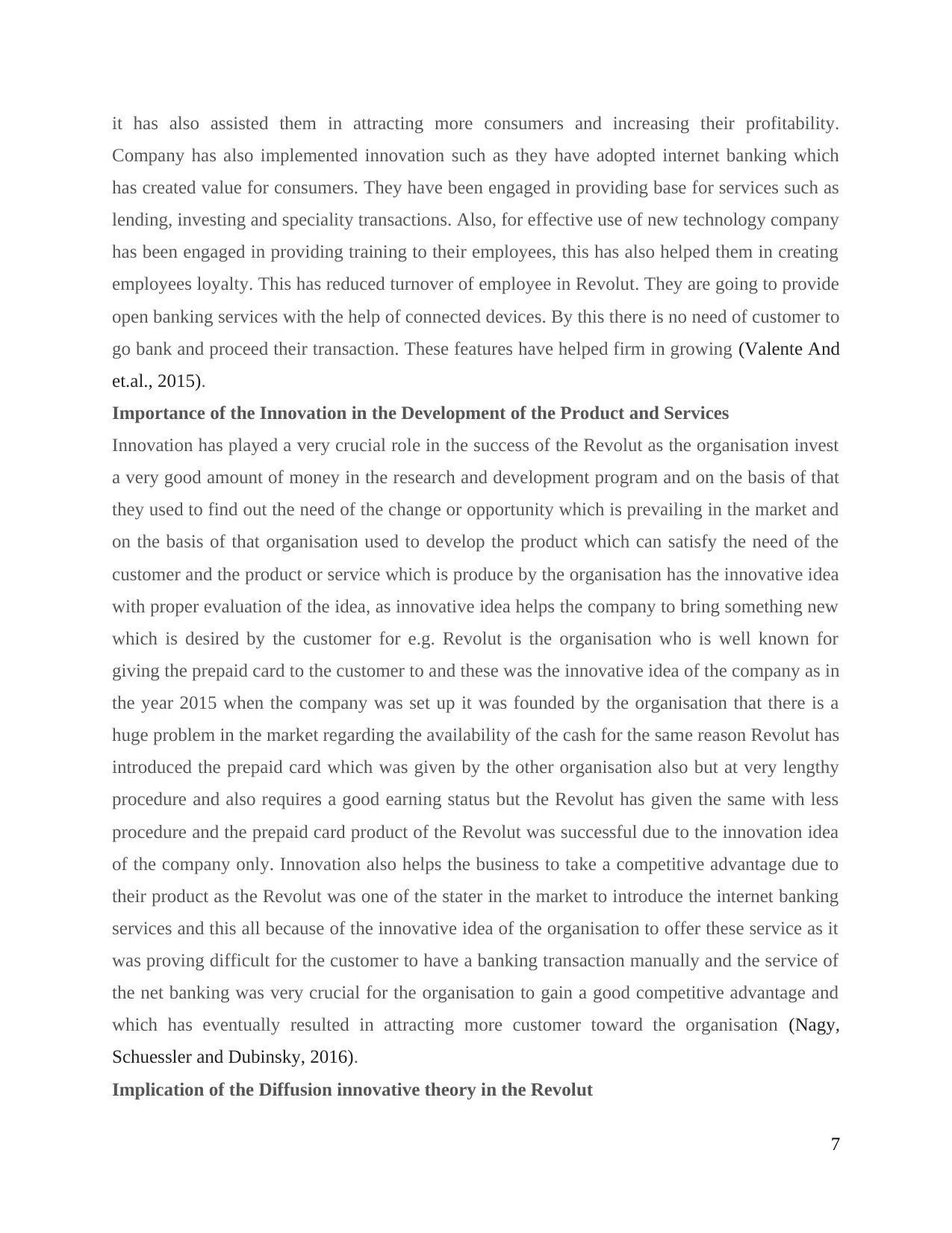
it has also assisted them in attracting more consumers and increasing their profitability.
Company has also implemented innovation such as they have adopted internet banking which
has created value for consumers. They have been engaged in providing base for services such as
lending, investing and speciality transactions. Also, for effective use of new technology company
has been engaged in providing training to their employees, this has also helped them in creating
employees loyalty. This has reduced turnover of employee in Revolut. They are going to provide
open banking services with the help of connected devices. By this there is no need of customer to
go bank and proceed their transaction. These features have helped firm in growing (Valente And
et.al., 2015).
Importance of the Innovation in the Development of the Product and Services
Innovation has played a very crucial role in the success of the Revolut as the organisation invest
a very good amount of money in the research and development program and on the basis of that
they used to find out the need of the change or opportunity which is prevailing in the market and
on the basis of that organisation used to develop the product which can satisfy the need of the
customer and the product or service which is produce by the organisation has the innovative idea
with proper evaluation of the idea, as innovative idea helps the company to bring something new
which is desired by the customer for e.g. Revolut is the organisation who is well known for
giving the prepaid card to the customer to and these was the innovative idea of the company as in
the year 2015 when the company was set up it was founded by the organisation that there is a
huge problem in the market regarding the availability of the cash for the same reason Revolut has
introduced the prepaid card which was given by the other organisation also but at very lengthy
procedure and also requires a good earning status but the Revolut has given the same with less
procedure and the prepaid card product of the Revolut was successful due to the innovation idea
of the company only. Innovation also helps the business to take a competitive advantage due to
their product as the Revolut was one of the stater in the market to introduce the internet banking
services and this all because of the innovative idea of the organisation to offer these service as it
was proving difficult for the customer to have a banking transaction manually and the service of
the net banking was very crucial for the organisation to gain a good competitive advantage and
which has eventually resulted in attracting more customer toward the organisation (Nagy,
Schuessler and Dubinsky, 2016).
Implication of the Diffusion innovative theory in the Revolut
7
Company has also implemented innovation such as they have adopted internet banking which
has created value for consumers. They have been engaged in providing base for services such as
lending, investing and speciality transactions. Also, for effective use of new technology company
has been engaged in providing training to their employees, this has also helped them in creating
employees loyalty. This has reduced turnover of employee in Revolut. They are going to provide
open banking services with the help of connected devices. By this there is no need of customer to
go bank and proceed their transaction. These features have helped firm in growing (Valente And
et.al., 2015).
Importance of the Innovation in the Development of the Product and Services
Innovation has played a very crucial role in the success of the Revolut as the organisation invest
a very good amount of money in the research and development program and on the basis of that
they used to find out the need of the change or opportunity which is prevailing in the market and
on the basis of that organisation used to develop the product which can satisfy the need of the
customer and the product or service which is produce by the organisation has the innovative idea
with proper evaluation of the idea, as innovative idea helps the company to bring something new
which is desired by the customer for e.g. Revolut is the organisation who is well known for
giving the prepaid card to the customer to and these was the innovative idea of the company as in
the year 2015 when the company was set up it was founded by the organisation that there is a
huge problem in the market regarding the availability of the cash for the same reason Revolut has
introduced the prepaid card which was given by the other organisation also but at very lengthy
procedure and also requires a good earning status but the Revolut has given the same with less
procedure and the prepaid card product of the Revolut was successful due to the innovation idea
of the company only. Innovation also helps the business to take a competitive advantage due to
their product as the Revolut was one of the stater in the market to introduce the internet banking
services and this all because of the innovative idea of the organisation to offer these service as it
was proving difficult for the customer to have a banking transaction manually and the service of
the net banking was very crucial for the organisation to gain a good competitive advantage and
which has eventually resulted in attracting more customer toward the organisation (Nagy,
Schuessler and Dubinsky, 2016).
Implication of the Diffusion innovative theory in the Revolut
7
Paraphrase This Document
Need a fresh take? Get an instant paraphrase of this document with our AI Paraphraser
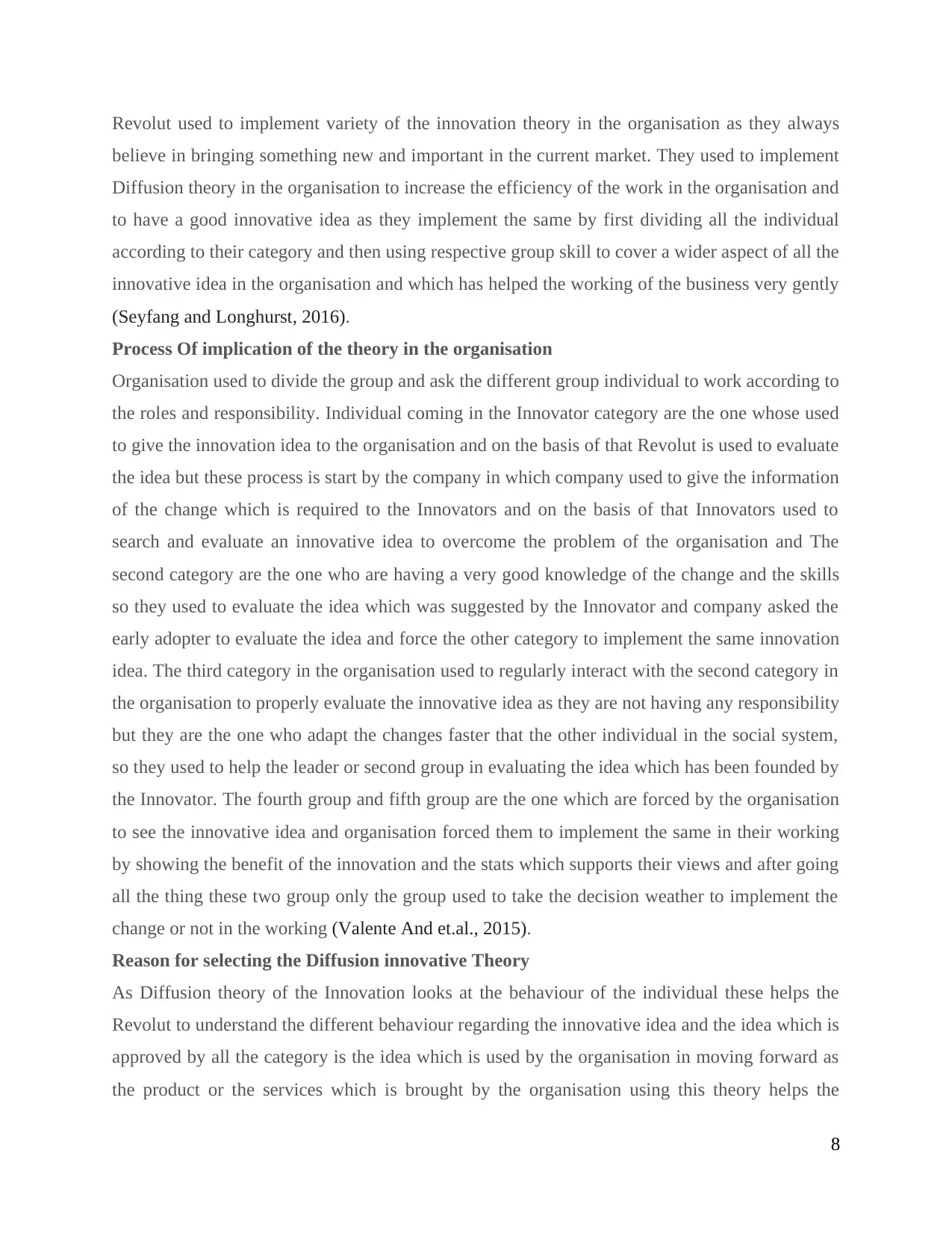
Revolut used to implement variety of the innovation theory in the organisation as they always
believe in bringing something new and important in the current market. They used to implement
Diffusion theory in the organisation to increase the efficiency of the work in the organisation and
to have a good innovative idea as they implement the same by first dividing all the individual
according to their category and then using respective group skill to cover a wider aspect of all the
innovative idea in the organisation and which has helped the working of the business very gently
(Seyfang and Longhurst, 2016).
Process Of implication of the theory in the organisation
Organisation used to divide the group and ask the different group individual to work according to
the roles and responsibility. Individual coming in the Innovator category are the one whose used
to give the innovation idea to the organisation and on the basis of that Revolut is used to evaluate
the idea but these process is start by the company in which company used to give the information
of the change which is required to the Innovators and on the basis of that Innovators used to
search and evaluate an innovative idea to overcome the problem of the organisation and The
second category are the one who are having a very good knowledge of the change and the skills
so they used to evaluate the idea which was suggested by the Innovator and company asked the
early adopter to evaluate the idea and force the other category to implement the same innovation
idea. The third category in the organisation used to regularly interact with the second category in
the organisation to properly evaluate the innovative idea as they are not having any responsibility
but they are the one who adapt the changes faster that the other individual in the social system,
so they used to help the leader or second group in evaluating the idea which has been founded by
the Innovator. The fourth group and fifth group are the one which are forced by the organisation
to see the innovative idea and organisation forced them to implement the same in their working
by showing the benefit of the innovation and the stats which supports their views and after going
all the thing these two group only the group used to take the decision weather to implement the
change or not in the working (Valente And et.al., 2015).
Reason for selecting the Diffusion innovative Theory
As Diffusion theory of the Innovation looks at the behaviour of the individual these helps the
Revolut to understand the different behaviour regarding the innovative idea and the idea which is
approved by all the category is the idea which is used by the organisation in moving forward as
the product or the services which is brought by the organisation using this theory helps the
8
believe in bringing something new and important in the current market. They used to implement
Diffusion theory in the organisation to increase the efficiency of the work in the organisation and
to have a good innovative idea as they implement the same by first dividing all the individual
according to their category and then using respective group skill to cover a wider aspect of all the
innovative idea in the organisation and which has helped the working of the business very gently
(Seyfang and Longhurst, 2016).
Process Of implication of the theory in the organisation
Organisation used to divide the group and ask the different group individual to work according to
the roles and responsibility. Individual coming in the Innovator category are the one whose used
to give the innovation idea to the organisation and on the basis of that Revolut is used to evaluate
the idea but these process is start by the company in which company used to give the information
of the change which is required to the Innovators and on the basis of that Innovators used to
search and evaluate an innovative idea to overcome the problem of the organisation and The
second category are the one who are having a very good knowledge of the change and the skills
so they used to evaluate the idea which was suggested by the Innovator and company asked the
early adopter to evaluate the idea and force the other category to implement the same innovation
idea. The third category in the organisation used to regularly interact with the second category in
the organisation to properly evaluate the innovative idea as they are not having any responsibility
but they are the one who adapt the changes faster that the other individual in the social system,
so they used to help the leader or second group in evaluating the idea which has been founded by
the Innovator. The fourth group and fifth group are the one which are forced by the organisation
to see the innovative idea and organisation forced them to implement the same in their working
by showing the benefit of the innovation and the stats which supports their views and after going
all the thing these two group only the group used to take the decision weather to implement the
change or not in the working (Valente And et.al., 2015).
Reason for selecting the Diffusion innovative Theory
As Diffusion theory of the Innovation looks at the behaviour of the individual these helps the
Revolut to understand the different behaviour regarding the innovative idea and the idea which is
approved by all the category is the idea which is used by the organisation in moving forward as
the product or the services which is brought by the organisation using this theory helps the
8
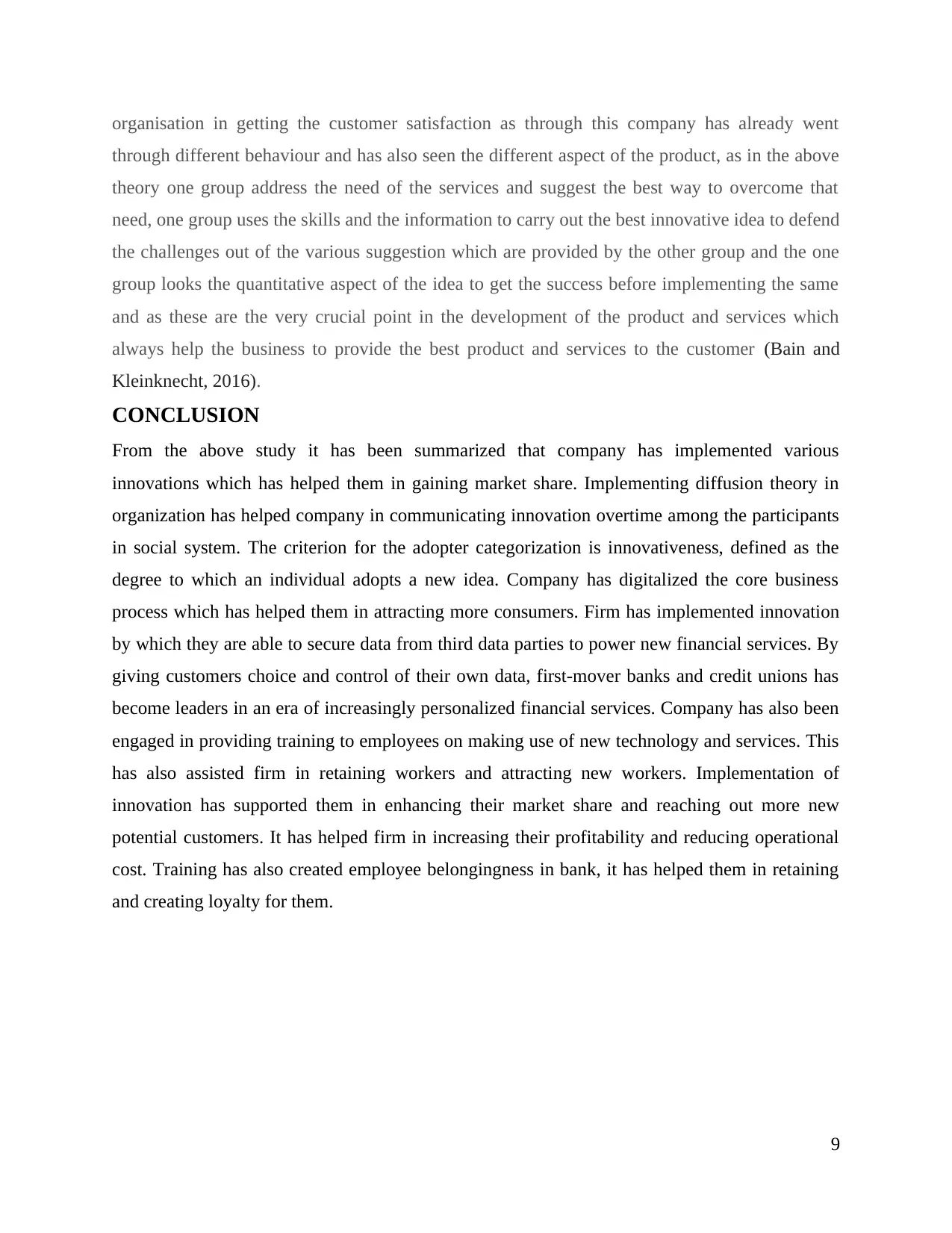
organisation in getting the customer satisfaction as through this company has already went
through different behaviour and has also seen the different aspect of the product, as in the above
theory one group address the need of the services and suggest the best way to overcome that
need, one group uses the skills and the information to carry out the best innovative idea to defend
the challenges out of the various suggestion which are provided by the other group and the one
group looks the quantitative aspect of the idea to get the success before implementing the same
and as these are the very crucial point in the development of the product and services which
always help the business to provide the best product and services to the customer (Bain and
Kleinknecht, 2016).
CONCLUSION
From the above study it has been summarized that company has implemented various
innovations which has helped them in gaining market share. Implementing diffusion theory in
organization has helped company in communicating innovation overtime among the participants
in social system. The criterion for the adopter categorization is innovativeness, defined as the
degree to which an individual adopts a new idea. Company has digitalized the core business
process which has helped them in attracting more consumers. Firm has implemented innovation
by which they are able to secure data from third data parties to power new financial services. By
giving customers choice and control of their own data, first-mover banks and credit unions has
become leaders in an era of increasingly personalized financial services. Company has also been
engaged in providing training to employees on making use of new technology and services. This
has also assisted firm in retaining workers and attracting new workers. Implementation of
innovation has supported them in enhancing their market share and reaching out more new
potential customers. It has helped firm in increasing their profitability and reducing operational
cost. Training has also created employee belongingness in bank, it has helped them in retaining
and creating loyalty for them.
9
through different behaviour and has also seen the different aspect of the product, as in the above
theory one group address the need of the services and suggest the best way to overcome that
need, one group uses the skills and the information to carry out the best innovative idea to defend
the challenges out of the various suggestion which are provided by the other group and the one
group looks the quantitative aspect of the idea to get the success before implementing the same
and as these are the very crucial point in the development of the product and services which
always help the business to provide the best product and services to the customer (Bain and
Kleinknecht, 2016).
CONCLUSION
From the above study it has been summarized that company has implemented various
innovations which has helped them in gaining market share. Implementing diffusion theory in
organization has helped company in communicating innovation overtime among the participants
in social system. The criterion for the adopter categorization is innovativeness, defined as the
degree to which an individual adopts a new idea. Company has digitalized the core business
process which has helped them in attracting more consumers. Firm has implemented innovation
by which they are able to secure data from third data parties to power new financial services. By
giving customers choice and control of their own data, first-mover banks and credit unions has
become leaders in an era of increasingly personalized financial services. Company has also been
engaged in providing training to employees on making use of new technology and services. This
has also assisted firm in retaining workers and attracting new workers. Implementation of
innovation has supported them in enhancing their market share and reaching out more new
potential customers. It has helped firm in increasing their profitability and reducing operational
cost. Training has also created employee belongingness in bank, it has helped them in retaining
and creating loyalty for them.
9
⊘ This is a preview!⊘
Do you want full access?
Subscribe today to unlock all pages.

Trusted by 1+ million students worldwide
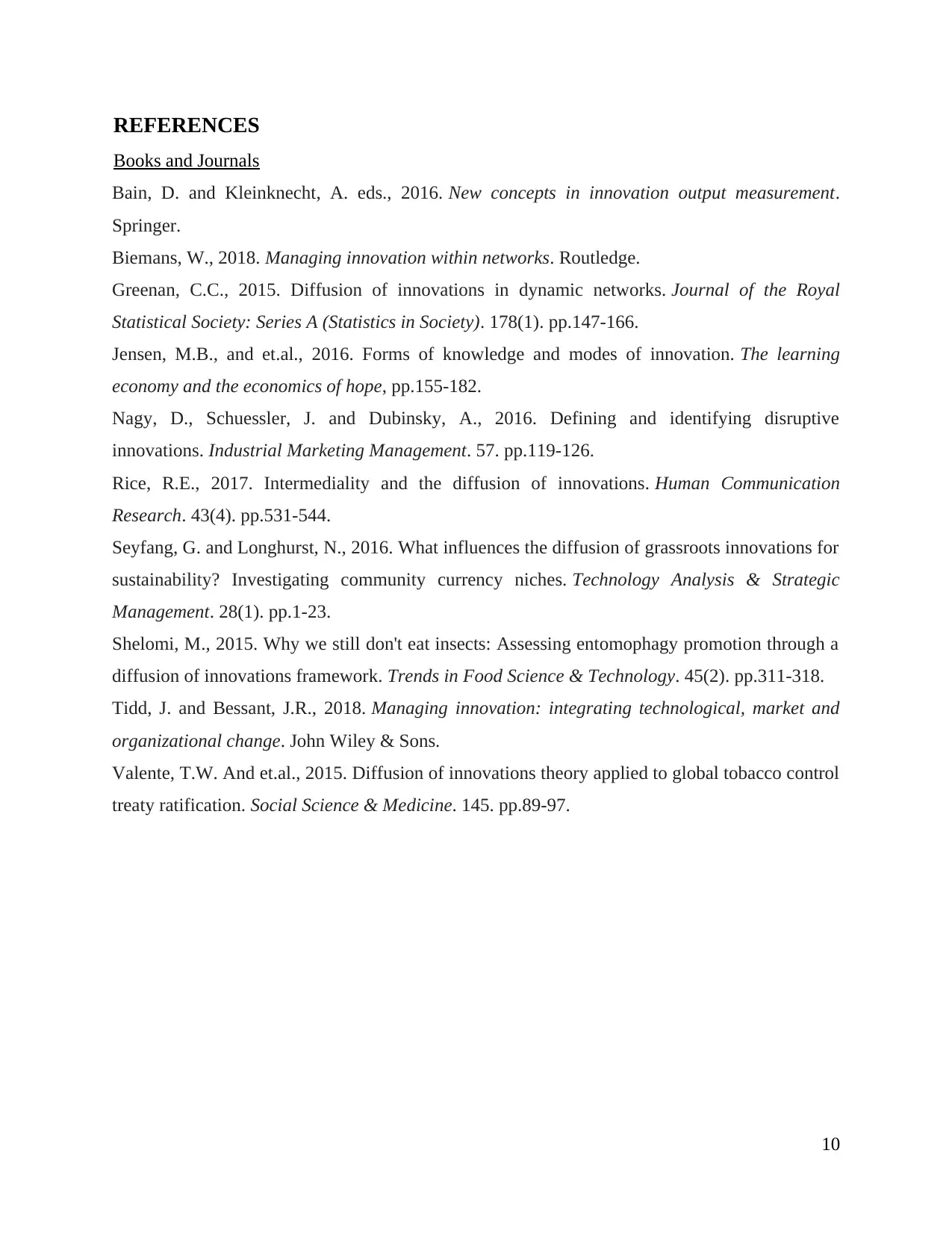
REFERENCES
Books and Journals
Bain, D. and Kleinknecht, A. eds., 2016. New concepts in innovation output measurement.
Springer.
Biemans, W., 2018. Managing innovation within networks. Routledge.
Greenan, C.C., 2015. Diffusion of innovations in dynamic networks. Journal of the Royal
Statistical Society: Series A (Statistics in Society). 178(1). pp.147-166.
Jensen, M.B., and et.al., 2016. Forms of knowledge and modes of innovation. The learning
economy and the economics of hope, pp.155-182.
Nagy, D., Schuessler, J. and Dubinsky, A., 2016. Defining and identifying disruptive
innovations. Industrial Marketing Management. 57. pp.119-126.
Rice, R.E., 2017. Intermediality and the diffusion of innovations. Human Communication
Research. 43(4). pp.531-544.
Seyfang, G. and Longhurst, N., 2016. What influences the diffusion of grassroots innovations for
sustainability? Investigating community currency niches. Technology Analysis & Strategic
Management. 28(1). pp.1-23.
Shelomi, M., 2015. Why we still don't eat insects: Assessing entomophagy promotion through a
diffusion of innovations framework. Trends in Food Science & Technology. 45(2). pp.311-318.
Tidd, J. and Bessant, J.R., 2018. Managing innovation: integrating technological, market and
organizational change. John Wiley & Sons.
Valente, T.W. And et.al., 2015. Diffusion of innovations theory applied to global tobacco control
treaty ratification. Social Science & Medicine. 145. pp.89-97.
10
Books and Journals
Bain, D. and Kleinknecht, A. eds., 2016. New concepts in innovation output measurement.
Springer.
Biemans, W., 2018. Managing innovation within networks. Routledge.
Greenan, C.C., 2015. Diffusion of innovations in dynamic networks. Journal of the Royal
Statistical Society: Series A (Statistics in Society). 178(1). pp.147-166.
Jensen, M.B., and et.al., 2016. Forms of knowledge and modes of innovation. The learning
economy and the economics of hope, pp.155-182.
Nagy, D., Schuessler, J. and Dubinsky, A., 2016. Defining and identifying disruptive
innovations. Industrial Marketing Management. 57. pp.119-126.
Rice, R.E., 2017. Intermediality and the diffusion of innovations. Human Communication
Research. 43(4). pp.531-544.
Seyfang, G. and Longhurst, N., 2016. What influences the diffusion of grassroots innovations for
sustainability? Investigating community currency niches. Technology Analysis & Strategic
Management. 28(1). pp.1-23.
Shelomi, M., 2015. Why we still don't eat insects: Assessing entomophagy promotion through a
diffusion of innovations framework. Trends in Food Science & Technology. 45(2). pp.311-318.
Tidd, J. and Bessant, J.R., 2018. Managing innovation: integrating technological, market and
organizational change. John Wiley & Sons.
Valente, T.W. And et.al., 2015. Diffusion of innovations theory applied to global tobacco control
treaty ratification. Social Science & Medicine. 145. pp.89-97.
10
Paraphrase This Document
Need a fresh take? Get an instant paraphrase of this document with our AI Paraphraser

11

12
⊘ This is a preview!⊘
Do you want full access?
Subscribe today to unlock all pages.

Trusted by 1+ million students worldwide
1 out of 13
Related Documents
Your All-in-One AI-Powered Toolkit for Academic Success.
+13062052269
info@desklib.com
Available 24*7 on WhatsApp / Email
![[object Object]](/_next/static/media/star-bottom.7253800d.svg)
Unlock your academic potential
Copyright © 2020–2025 A2Z Services. All Rights Reserved. Developed and managed by ZUCOL.





